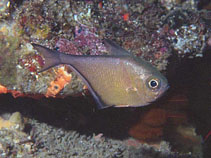| Family: |
Pempheridae (Sweepers) |
| Max. size: |
17 cm TL (male/unsexed) |
| Environment: |
reef-associated; marine; depth range 0 - 20 m |
| Distribution: |
Indo-Pacific: widely distributed and abundant in the Indian Ocean (including the Red Sea to Andaman Sea) to the Pacific; not in the Mediterranean Sea. Regional variations present in the Indian, Andaman and the Pacific. |
| Diagnosis: |
Dorsal spines (total): 6-6; Dorsal soft rays (total): 8-10; Anal spines: 3-3; Anal soft rays: 36-45; Vertebrae: 25-25. This species is distinguished by the following characters: pectoral fin base with a faint blackish spot; pored lateral-line scales 56-64 (Andaman Sea 52-58; Pacific 51-62); scale rows above lateral line 4.5-6.5 (usually 5.5; Andaman Sea and the Pacific Ocean, 4.5-5.5, usually 4.5); circumpeduncular scales 14-18 (usually 16); outer edge of anal fin with a distinct blackish band (rarely faint or only anterior half prominent; usually none in Pacific); posterior edge of caudal fin with a blackish band (caudal fin whole yellowish in Andaman Sea); upper-jaw length 14.2-15.6% SL; body depth 41.4-45.4% SL. Individuals in the Pacific are distinguished from its congeners by the following set of characters: ctenoid and deciduous scales are thin and semicircular in shape; 51-62 pored lateral-line scales; 4.5-5.5 (usually 4.5) scale rows above lateral line; pectoral fin base with a faint blackish spot; anal fin usually have no blackish outer margin; anal fin base with a dusky band (Ref. 95675). |
| Biology: |
This fish is common on coral reefs (Ref. 6645); forming aggregations in caves or crevices or under overhangs (Ref. 48636) by day, but a few may at times be seen in the open, close to the shelter of reefs. This species is also observed forming small groups with Myripristis murdjan at 0.5-1 m below the surface. At night, it is known to feed on zooplankton (Ref. 94773). Spawning occur during April to June, and is year-round in Okinawa I. (Koeda et al., in press - in Ref. 95675). Spawning occurred after sunset with individuals larger than 11 cm SL joining the spawning group (Ref. 95675). Flesh is edible (Ref. 12484). |
| IUCN Red List Status: |
Not Evaluated (N.E.) Ref. (130435)
|
| Threat to humans: |
harmless |
Source and more info: www.fishbase.org. For personal, classroom, and other internal use only. Not for publication.

